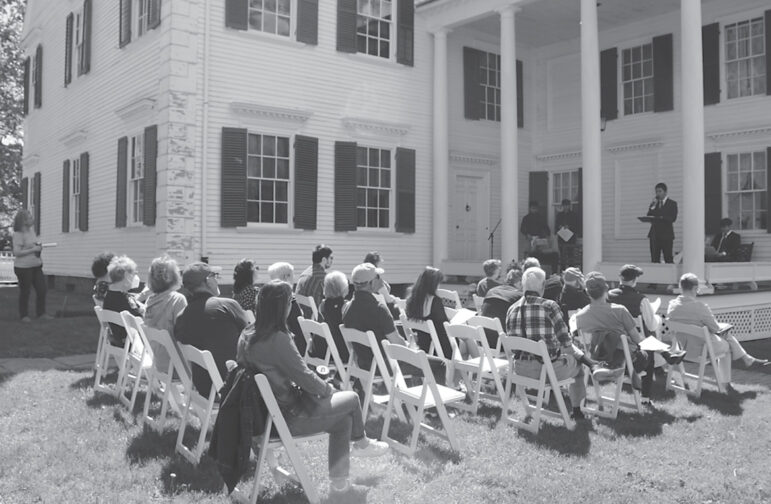In the continuing program to identify early Black residents who were owned in Suffield, an interested group gathered at the Phelps-Hatheway House to learn about Witness Stones. Oliver Phelps, one of Suffield’s most prominent citizens, lived and worked at one time at the well-known landmark where they were being recognized. The program included historical information uncovered by students of Suffield Academy in the American Studies program taught by Bill Sullivan, who is also a trustee of the Suffield Historical Society.
The program opened with welcoming remarks by Academy senior Hope Clark. She commented that it is a surprise to many that descendants of American Aboriginal culture the Haudenosee “Indians” of the Finger Lakes region might be placed under the supervision of African Americans owned by an American businessman: Oliver Phelps.
Rev. Diann Bailey of Suffield’s First Congregational Church pointed out in her added welcoming remarks that Phelps, the most prominent Suffield businessman of that period, was a major developer of the Western New York region. Lynn Mervosh, Phelps Hatheway administrator for Connecticut Landmarks, of which the property is a major asset, also welcomed the visitors. Then honorary guest Mel Chafetz, one of the Suffield Board of Selectmen, added a final welcome on behalf of the town and thanked Academy teacher Bill Sullivan for his students’ role in developing the information underlying this Witness Stone installation.

Chairs were set up at a convenient spot by the Phelps-Hatheway House on May 6 for interested folks who wanted to learn about two enslaved Blacks who had been owned there. Many more visitors were present, out of the photo at the left.
The two Suffieldians owned by Oliver Phelps and being recognized by two new Witness Stones are Lewis Butler and his wife Barbara Nichols Butler.
The “meat” of the brief program followed, with presentations from the students: Rhys Babcock, Harry Xu, Kaitlyn Welsh and Haden Kriston. Several acrostic poems were read by students Jason Hall and Mekhi Johnson, and student Ken Pardo thanked the audience for their participation in the program. All the students were seniors, and the program was clearly structured for tutorial purposes as well as to recognize the two Black Suffieldians. It seemed quite appropriate that Sonia Hill of the Third Baptist Church closed the program with her moving rendition of “I sing because I’m Happy . . . and I know He Watches Over Me.”
The Witness Stones for Barbara and Lewis Butler were placed for examination on the edge of the Phelps-Hatheway entrance porch. A date for their installation has not been set.